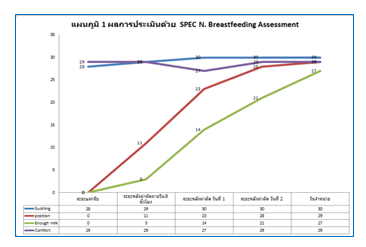ผลของการใช้เครื่องมือประเมินการเลี้ยงลูกด้วยนมแม่ SPEC.N Breastfeeding Assessment กับความสำเร็จของการเลี้ยงลูกด้วยนมแม่ก่อนจำหน่ายในมารดาหลังผ่าตัดคลอด โรงพยาบาลมหาราช นครศรีธรรมราช
คำสำคัญ:
เด็กพิเศษ , ความเครียด , ประสิทธิผลการปกครองบทคัดย่อ
การวิจัยกึ่งทดลองนี้ เพื่อศึกษาผลของการใช้เครื่องมือประเมินการเลี้ยงลูกด้วยนมแม่ SPEC.N Breastfeeding Assessment กับความสำเร็จของการเลี้ยงลูกด้วยนมแม่ก่อนจำหน่าย กลุ่มตัวอย่าง คือ มารดาหลังผ่าตัดคลอดที่ได้รับการเตรียมผ่าตัดคลอดและพักหลังคลอดที่หอผู้ป่วยพิเศษเฉลิมพระบารมี 3 - 4 โรงพยาบาลมหาราช นครศรีธรรมราช จำนวน 30 ราย ในเดือนธันวาคม พ.ศ. 2566 คัดเลือกแบบเจาะจง ใช้เครื่องมือประเมินการเลี้ยงลูกด้วยนมแม่ SPEC.N Breastfeeding Assessment และเครื่องมือประเมินประสิทธิภาพของการให้นม วิเคราะห์ข้อมูลโดยใช้สถิติพรรณนา
ผลการวิจัย พบว่า มารดาหลังผ่าตัดคลอดที่ใช้เครื่องมือประเมินการเลี้ยงลูกด้วยนมแม่ SPEC.N Breastfeeding Assessment ในระยะแรกรับหลังผ่าตัด หลังผ่าตัดภายใน 8 ชั่วโมง หลังผ่าตัดวันที่ 1 หลังผ่าตัดวันที่ 2 และวันจำหน่าย มีผลประเมินการดูดนม ผ่านร้อยละ 93.33, 96.67, 100.00, 100.00, และ 100.00 ผลประเมินการเข้าเต้าหรือการอุ้มลูกเข้าดูดนม ผ่านร้อยละ 0.00, 36.67, 76.67, 93.33 และ 96.67 ผลประเมินการได้รับนมแม่เพียงพอ ผ่านร้อยละ 0.00, 10.00, 46.67, 70.00 และ 90.00 ผลประเมิน ความสุขสบายของหัวนมและเต้านม ผ่านร้อยละ 96.67, 96.67, 90.00, 96.67 และ 96.67 ตามลำดับ ค่าเฉลี่ยผลการประเมินประสิทธิภาพของการให้นมในระยะแรกรับหลังผ่าตัดและวันจำหน่าย ค่าเฉลี่ยอยู่ที่ 5.30 (S.D.= 1.09) และ 8.93 (S.D.= 1.34) และร้อยละ 90.00 ของมารดาหลังผ่าตัดคลอด ประสบความสำเร็จในการเลี้ยงลูกด้วยนมแม่ จะเห็นได้ว่า ค่าเฉลี่ยผลการประเมินประสิทธิภาพของการให้นมในวันจำหน่ายสูงกว่าระยะแรกรับหลังผ่าตัด และมารดาหลังผ่าตัดคลอดประสบความสำเร็จในการเลี้ยงลูกด้วยนมแม่ก่อนจำหน่ายสูง แสดงให้เห็นว่า มารดาหลังผ่าตัดคลอด สามารถให้นมแม่ได้อย่างถูกวิธี ทารกได้รับนมเพียงพอ และมารดาไม่มีอาการคัดตึงเต้านมหรือเจ็บหัวนม ทั้งนี้ เนื่องจากเครื่องมือช่วยให้การประเมินการเลี้ยงลูกด้วยนมแม่ตรงประเด็นตั้งแต่แรกรับ และมีการติดตามประเมินอย่างต่อเนื่อง เมื่อพบปัญหาก็ได้รับการช่วยเหลือ แก้ไขปัญหาตามแนวทางการพยาบาลที่เหมาะสม
ดังนั้น จึงควรนำเครื่องมือประเมินการเลี้ยงลูกด้วยนมแม่ SPEC.N Breastfeeding Assessment ไปใช้ในการส่งเสริมการเลี้ยงลูกด้วยนมแม่ สำหรับมารดาหลังผ่าตัดคลอด เพื่อเพิ่มความสำเร็จในการเลี้ยงลูกด้วยนมแม่ก่อนจำหน่าย
เอกสารอ้างอิง
Baimonta, L., Nirattharadorn, M., & Kamolwarin, S. (2015). The effect of promoting breastfeeding program on maternal breastfeeding and milk flow among women experiencing cesarean section. Nursing Journal, 42(4), 65-75.
Baiya, N., Ketsuwan, S., Pachaiyapoom, N., & Puapornpong, P. (2013). Mother’s knowledge, latch score and satisfaction after development support service in HRH Princess Maha Chakri Sirindhorn Medical Center. Journal of Medicine and Health Sciences, 20(2), 17-23.
Budsaengdee, B. (2014). Self-efficacy promotion on success in exclusive breastfeeding among cesarean section mothers. Thai Red Cross Nursing Journal, 7(1), 1-9.
Budsaengdee, B., Kantaruksa, K., & Chareonsanti, J. (2013). Effects of self-efficacy promotion on success in exclusive breastfeeding among cesarean section mother. Nursing Journal, 40(3), 1-10.
Evans, K. C., Evans, R. G., Royal, R., Esterman, A. J., & James, S. L. (2003). Effect of cesarean section on breast milk transfer to the normal term newborn over the first week of life. Archives of Disease in Childhoo Fetal and Neonatal Edition, 88(5), 380-382.
Jinpol, P. (2023). Applied Statistic for Research. Nakhonsrithammarat: K. pulprinting. (in Thai)
Pérez-Rios, N., Rimos-Valencia, G., & Ortiz, A. P. (2008). Cesarean delivery as a barrier for breastfeeding initiation: the Puerto Rican experience. Journal of Human Lactation: Official Journal of International Lactation Consultant Association, 24(3), 293–302.
Puapornpong, P., Raungrongmorakot, K., Hamontri, S., Ketsuwan, S. & Wongin,S. (2016). Latch score and exclusive breastfeeding during first six months postpartum. Journal of Medicine and Health Sciences. 23(1), 9-14.
Rowe-Murray, H. J., & Fisher, J. R. (2002). Baby friendly hospital practices: cesarean section is a persistent barrier to early initiation of breastfeeding. Birth (Berkeley, Calif.), 29(2), 124-131.
Saengpheng, L. (2022). Development of a breastfeeding assessment tool and evaluation of its use in postpartum ward of Maharaj Nakorn Si Thammarat Hospital. Journal of Health Sciences and Pedagogy, 2(1), 55-66.
Techamuanwaiwit, S., Keereewichian, P., & Suvithayasiri, K. (2021). Promotion of breastfeeding after cesarean section: literature review. Journal of Health and Nursing Research, 37(3), 23-35.
Tharana, N. (2020). Promoting and supporting breastfeeding in postpartum mothers with cesarean section. Nursing Journal, 48(4), 324-335.
Wijitsukon, K., Sangpaum, P., Wattayu, N., Roungjiraschear, S., & Payackroung, S. (2012). Breastfeeding (2nd ed.) Bangkok: Faculty of nursing, Mahidol University. (in Thai)
Wongphinit, U. (2015). Nurse’s role in promoting exclusive breastfeeding at hospital discharge. Thai Red Cross Nursing Journal, 8(1), 24-32.

ดาวน์โหลด
เผยแพร่แล้ว
รูปแบบการอ้างอิง
ฉบับ
ประเภทบทความ
สัญญาอนุญาต
ลิขสิทธิ์ (c) 2024 วิทยาลัยพยาบาลบรมราชชนนี นครศรีธรรมราช

อนุญาตภายใต้เงื่อนไข Creative Commons Attribution-NonCommercial-NoDerivatives 4.0 International License.
บทความที่ได้รับการตีพิมพ์เป็นลิขสิทธิ์ของ วิทยาลัยพยาบาลบรมราชชนนี นครศรีธรรมราช
ข้อความที่ปรากฏในบทความแต่ละเรื่องในวารสารวิชาการเล่มนี้เป็นความคิดเห็นส่วนตัวของผู้เขียนแต่ละท่านไม่เกี่ยวข้องกับวิทยาลัยพยาบาลบรมราชชนนี นครศรีธรรมราช และบุคคลากรท่านอื่น ๆ ในวิทยาลัยฯ แต่อย่างใด ความรับผิดชอบองค์ประกอบทั้งหมดของบทความแต่ละเรื่องเป็นของผู้เขียนแต่ละท่าน หากมีความผิดพลาดใดๆ ผู้เขียนแต่ละท่านจะรับผิดชอบบทความของตนเองแต่ผู้เดียว





